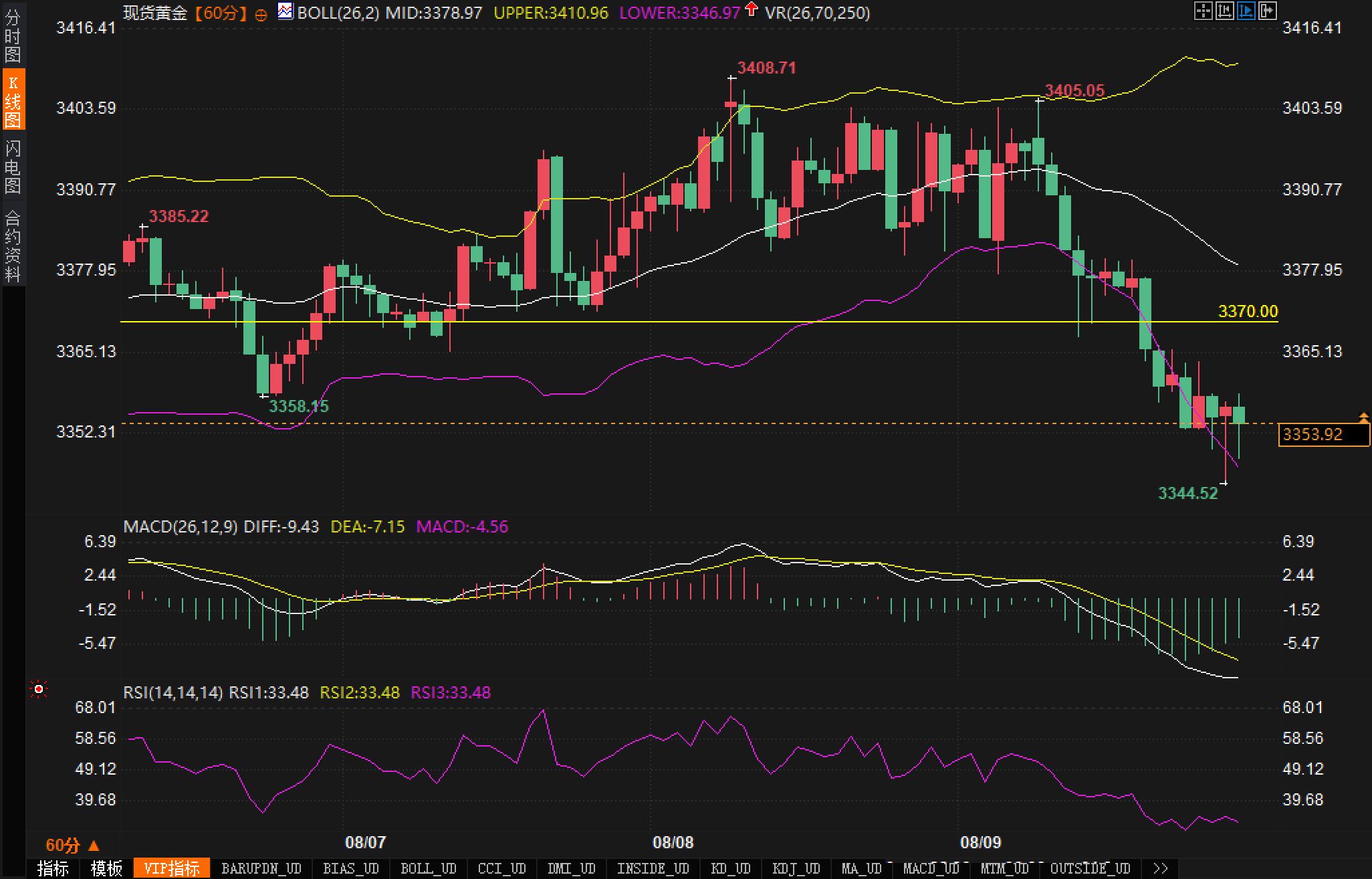From the Alaska meeting to CPI, there are two scenarios for gold's next move
2025-08-11 22:02:38

Fundamentals
Recent trends are driven by two main factors: expectations of a marginal easing in geopolitical risks; and a focus on the Federal Reserve's September rate cut. Last weekend, renewed diplomatic activity drew attention. The White House announced that the president will meet with Russia in Alaska on August 15th, aiming to facilitate ceasefire and framework negotiations. Analysts believe that while differences remain between the two sides' demands—Moscow emphasizes "territorial recognition, neutrality, and sanctions arrangements" while Kyiv emphasizes "a complete ceasefire, territorial recovery, and security guarantees"—the mere presence of a meeting at the table weakens the safe-haven premium, putting pressure on gold.
Interest rates provide a buffer for gold prices. CME FedWatch shows that the market is pricing in a solid 88% probability of a 25 basis point rate cut in September. Concerns about cooling growth and a weakening labor market are hindering the dollar and Treasury yields from strengthening. The DXY hovered near a two-week low, remaining above 98.00. On the Treasury side, the 10-year yield approached 4.262% on Monday, while the 30-year yield fell to 4.825%, halting its previous upward trend. Lower interest rates and a lower discount factor are supporting the medium-term valuation of gold, a non-interest-bearing asset.
In terms of risk appetite, strengthening global equities are also reducing gold's appeal. Last Friday, the Nikkei 225 closed up 1.85%, with futures nearing a record high. European markets opened higher on Monday before fluctuating and retreating. The UK's FTSE 100 rose 0.26% to 9,118 in early trading. India's Sensex closed up 746 points at 80,604 last week. The "profitability" of risky assets is prompting rebalancing ahead of this week's intensive macroeconomic data releases, which is in turn reducing gold allocations.
Public opinion is also being roiled. On August 7th, the United States officially implemented reciprocal tariffs, raising overall tariffs to an estimated 18.6%—the highest level since 1934—and affecting over 60 trading partners. Meanwhile, rumors of whether this would affect the commonly seen Swiss 1kg and 100oz gold bars have sparked supply chain concerns. Recent developments indicate that the White House intends to exempt gold bars through an executive order. As the market awaits finalization, the uncertainty surrounding this has temporarily eased.
Monetary policy pronouncements continue to fuel the "rate cut story." Last weekend, Federal Reserve Vice Chairman Bowman expressed support for a September rate cut and favored three rate cuts for the entire year. Kashkari and Mary Daly also mentioned potential for "approximately two" cuts this year. If inflation tracks this week, downward expectations for interest rates will solidify.
Monday's lack of major data this week is just a prelude; the rhythm will be determined by the following three releases: CPI on Tuesday, PPI on Thursday, and retail sales and preliminary Michigan data on Friday. If inflation continues to decline, second-order expectations of the probability and magnitude of a rate cut will rise. If a sticky upward trend emerges, gold will face pressure from "interest rate repricing."
Technical aspects:
After forming a double high at 3405.05 and 3408.71, the price has been declining steadily. The middle Bollinger band at 3378.97 has been effectively broken, turning into resistance. The latest candlestick chart is trading close to the lower Bollinger band at 3346.97, with a significantly wider band than previously, suggesting a downward trend rather than simple sideways fluctuations. Key intraday levels are clear: the structural level below the previous high at 3385.22 and the horizontal pivot at 3370.00 form the first upper resistance band. A pullback to the middle band would create a negative gap between 3378.97 and the lower edge of the upper band, creating a negative bullish environment. Support lies below the lower Bollinger band at 3346.97 and the recent low at 3344.52. The earlier step low at 3358.15 has been broken, indicating rising short-term supply and effective resistance.

The momentum indicators are showing a resonant bearish bias. The MACD DIFF -9.43/DEA -7.15 are both below the zero axis and the opening is widening. The bar value of -4.56 indicates that the downward momentum is still being released, and a credible "bottom divergence" has not yet appeared. The RSI (14) is near 33.48, in the weak range of 30-40, close to the "oversold edge" but not to the extreme. Combined with the K-line body closing below the middle line for a period of time, the short-term rebound is more likely to be a retracement of 3370-3379 rather than a sudden reversal of the structure. If 3346.97 is effectively broken through and closed below it, technically it will open up the space for retesting around 3344.52; conversely, if 3370.00 can be effectively recovered and the middle line can be stabilized, it will be considered a phased correction of the downward rhythm.
Market Sentiment Observation
Looking at cross-asset correlations, gold has maintained a negative correlation with the DXY recently, while its correlation with the US Treasury term spread has strengthened during event windows. Monday's sentiment framework can be summarized as "reducing risk aversion + supportive interest rates." On the one hand, the "tail risk premium compression" driven by diplomatic issues has driven capital into riskier assets, passively weakening gold's safe-haven resilience. On the other hand, the high probability of a September rate cut remains at 88%, and the upper anchor for interest rates remains, suppressing the speed of gold's significant decline. Market sentiment indicators are bearish but not panic-driven: the RSI has not yet broken through 30, and the MACD, while weak, has a steady rhythm, indicating no signs of accelerated panic selling. At the options level (inferred from the typical performance of implied volatility), the trend is more like a one-sided trend with moderately rising volatility, rather than an event-driven outbreak. For traders, the current market consensus is more like "trend-dominant, rebounds primarily driven by retracements."
Market Outlook
Bullish scenario (weaker data/reheated diplomacy)
If the CPI and PPI continue their modest decline this week, signaling cooling demand, expectations for rate cuts will shift from a "number" to a "magnitude" of rate cuts. A downward revision in the yield-to-real interest rate will boost gold's discount value. If further clues about a ceasefire framework are released before and after the Alaska summit on August 15, the safe-haven discount could widen. Technically, only if prices break back above 3370.00 and reclaim the 3378.97 mid-range could bulls hope for a second attempt at the 3385.22 and 3400-3408 ranges. Further support would require a break above the upper Bollinger band at 3410.96 and a backtest to confirm this, before discussing a trend reversal and the re-establishment of a medium-term bullish structure.
Bearish scenario (sticky inflation/yields rise again)
If inflation becomes stickier than expected or retail sales and confidence data rebound, market bets on a September rate cut will recede, leading to renewed gains in 10-year and long-term yields, potentially triggering a new downward trend in gold prices. The technical trigger is a breakout and confirmation close between 3346.97 and 3344.52. Once this combination of a large-volume breakout below the lower band and downward pressure from the middle band is achieved, bears will target resistance at 3370/3379 before assessing the potential appeal of lower levels. It's important to note that the RSI isn't currently extreme; if a breakout and subsequent sharp decline occur, caution is warranted against potential technical rebounds (mean reversion).
Short-term (1-3 days) focus on inflation data-driven interest rate repricing and the 3370-3347 range. Medium-term (1-3 weeks) focus on the August 15 diplomatic incident and the Federal Reserve's forward guidance. A risk to watch out for: If the official text regarding gold bar tariff exemptions is released later than expected, it could trigger temporary price differentials and liquidity distortions on the supply side, thereby amplifying intraday volatility.
- Risk Warning and Disclaimer
- The market involves risk, and trading may not be suitable for all investors. This article is for reference only and does not constitute personal investment advice, nor does it take into account certain users’ specific investment objectives, financial situation, or other needs. Any investment decisions made based on this information are at your own risk.





















